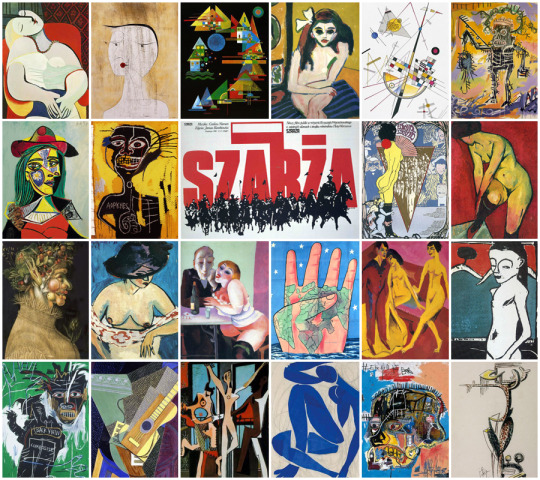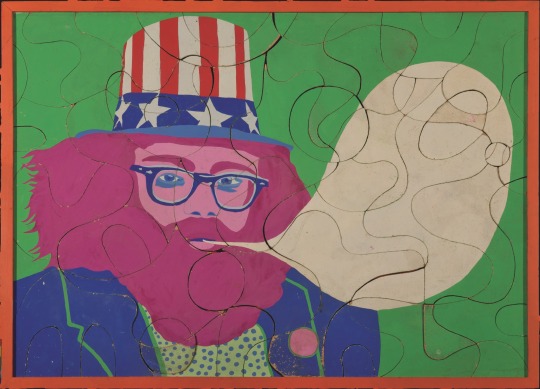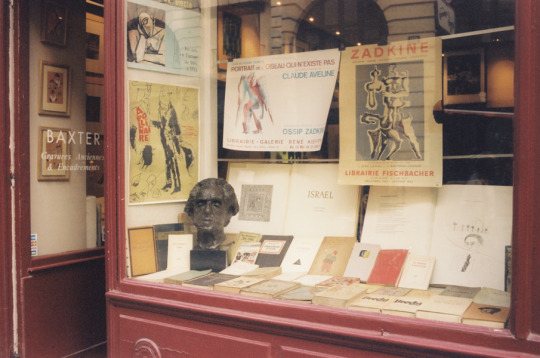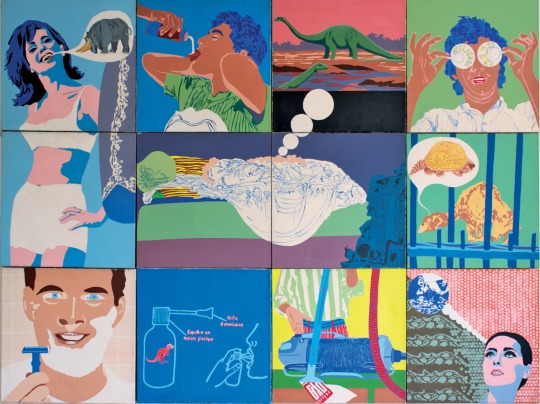#Johnny Friedlaender
Text

Johnny Friedlaender - Mi Octobre
12 notes
·
View notes
Text
Most Famous Abstract Art Artists and Artworks In The Last 100 Years

2/8/2024
♦ Framed Poster Print
♦ Canvas Print
♦ Metal Print
♦ Acrylic Print
♦ Wood Prints
🌐 Worldwide shipping
#Hans Hofmann#Ivan Kljun#Jan Voss#Jean Dubuffet#Jean Rene Bazaine#Jean Tinguely#Jean-Paul Riopelle#Jo Delahaut#Joan Hernandez Pijuan#Joaquin Torres-garcia#Johannes Itten#Johnny Friedlaender#Jonathan Lasker#Josef Albers#Juan Gris#Julius Bissier#Karel Appel#Kenneth Noland#Larry Zox#Laszlo Moholy-Nagy
3 notes
·
View notes
Photo

Rainbow II
Johnny Friedlaender
1971
2 notes
·
View notes
Photo



Keiko Minami (1911 – 2004) was a Japanese artist, engraver, and poet.
Keiko Minami, orphaned at a young age, expressed an early interest in the arts. She both painted and wrote poetry in high school, and studied the art of children's stories under the Japanese novelist and poet Sakae Tsuboi.
Her artistic style was influenced by such artists as Paul Klee, Hamaguchi Yōzō, Johnny Friedlaender, Mori Yoshio, and Japanese print artists. After the war, Keiko moved to Tokyo to create children's books, and it was there that she met her future husband, the mezzotint artist Hamaguchi Yōzō. Keiko and Yōzō moved to Paris in late 1953 where Keiko began studying under Johnny Friedlaender, a pioneer in aquatint etching.
33 notes
·
View notes
Text

Johnny Friedlaender
1912 Pless – Paris 1992
Paysage 7
Oil on canvas. (19)82.
Karl and Faber
15 notes
·
View notes
Text
Isabel Pons Iranzo (1912- 2002) diseñadora, ilustradora, pintora y profesora hispano-brasileña.

Nació en Barcelona. Cursó estudios de pintura y dibujo en la Escuela de Bellas Artes de Barcelona del 1925 al 1930. Durante el mismo periodo, estudió en la Escuela Industrial de Sabadell, con Joan Vila Cinca y Antoni Vila Arrufat, entre otros. Entre 1930 y 1940 trabajó en el estudio del pintor Carlos Vázquez y en el Real Círculo Artístico de Barcelona.

En el año 1931 participó en el concurso de pintura Montserrat vist pels pintors catalans, organizado por el Cercle Artístic de Sant Lluc. Las obras de los artistas que concurrieron se expusieron en el Palacio de las Artes Decorativas de Barcelona entre diciembre de 1931 y febrero de 1932.

Alrededor de 1935, realizó ilustraciones para libros del poeta Federico García Lorca.
En 1945 se trasladó a Río de Janeiro y en 1957 enseñó grabado en la Escuela de Artes Visuales del Parque Lage.
Se naturalizó brasileña el 1958 y estudió con Rossini Pérez y Johnny Friedlaender en el Estudio de Grabado del Museo de Arte Moderno de Río de Janeiro en 1959.

Relacionada con las entidades artísticas del país, se integró a la Comisión Nacional de Bellas artes (1964-67) y participó en exposiciones como la Bienal de Sao Paulo, en la cual consiguió el premio de grabado en 1961.

Después de catorce años de no exponer en salas catalanas, en 1975 presentó una importante muestra en Barcelona.

Tiene obra representada en varios museos de Río de Janeiro, en el de la Universidad de São Paulo y en varios museos de ciudades de todo el mundo, como Nueva York, Cleveland, La Paz y Madrid, entre otras.

En Cataluña, conservan obra de Isabel Pons Iranzo el Museu de Montserrat y el Museu de Historia de la Ciutat de Girona.

Murió en Río de Janeiro.

Le ponemos cara.

0 notes
Photo

Johnny Friedlaender (German, 1912 –1992)
Untitled
Color Lithograph, 30" x 22-1/4"
2 notes
·
View notes
Photo

Exposition Art Blog Johnny Friedlaender
Johnny Friedlaender (26 December 1912 – 18 June 1992) was a leading 20th-century artist, whose works have been exhibited in Germany, France, Netherlands, Italy, Japan and the United States. He has been influential upon other notable artists, who were students in his Paris gallery. His preferred medium of aquatint etching is a technically difficult artistic process, of which Friedlaender has been a pioneer.Gotthard Johnny Friedlaender was born in Pless (Pszczyna), Prussian Silesia, as the son of a pharmacist. He was graduated from the Breslau (Wrocław) high school in 1922 and then attended the Academy of Arts (Akademie der Bildenden Kunste) in Breslau, where he studied under Otto Mueller. He graduated from the Academy as a master student in 1928. In 1930 he moved to Dresden where he held exhibitions at the J. Sandel Gallery and at the Dresden Art Museum. He was in Berlin for part of 1933, and then journeyed to Paris. After two years in a Nazi concentration camp, he emigrated to Czechoslovakia, where he settled in Ostrava, where he held the first one-man show of his etchings .........More
3 notes
·
View notes
Text
An apprentice turns artist

‘Paris Calligrammes’ (2020) Review
Ulrike Ottinger drives her petite sky-blue Isetta with owls she has painted on it herself towards Paris in 1962. The car breaks down due to engine damage. She hitchhikes only to find a cool black Citroën stopping. This big car has five men in it. Ottinger assumes they are bank robbers but feels safe around them. They bring her to Paris.
She is 20, and has gone there to become an important artist. “Everything fascinated me,” she says, “walking and seeing became my most exhilarating pastime.” Calligrammes, on the other hand, is the title of a “collection of poetry by Guillaume Apollinaire, published in French in 1918,” according to Encyclopaedia Britannica. The subtitle of this collection is “Poems of Peace and War.”
She walks around with and sees everything through a camera. This helps this documentary find its footing and footage very much. It is her personal account, nonetheless, that breathes life into the film.

Yes, Paris is the protagonist. There are so many details, people, and places, though, that you will lose count of them. Each of them has a backstory that is equally interesting. And tangentially fascinating to why the 20-year-old set out to Paris in the first place.
To exemplify, she reads out from her French book in English. It turns out that almost all of it but the last line is a quote from a polymath, who died in a forest at the age of 41, with an open copy of ‘Hamlet’ by his body:
“Advice to the good traveller:
A town at the end of the road.
And road extending a town.
Do not choose one or the other.
But one and the other by turns.
I gladly followed that advice of Victor Segalen”
If I were to detail the backgrounds and trivia about each of the individuals that Ottinger goes through in the course of her 129-minute documentary, I would be writing about 20th century France and not about Ottinger's 2020 film. I will stick to the prominent ones because the documentary is about the artists she meets. She herself has made the job easier by dividing the film to ten chapters.

Fritz Picard of the Librairie Calligrammes is first. The name ‘Baxter’ has replaced ‘Calligrammes’ today, and the storefront has Ottinger’s books. Back then, too, it was a place for “anyone with an interest in German literature.” “An antiquarian bookstore” which was a hangout for the Jews. Most books were authored by banned writers, or rescued from being burnt in Nazi Germany.
Picard, in a 1963 interview, says that his bookstore houses everything “from Goethe all the way ‘downhill’ to 1933.” He had to flee, however, leaving behind his beautiful private collection. Famous names from 1952 onwards drown Picard’s guest book, which Ottinger finds in time for her film. Of actors, artists, scholars, sculptors, writers, Dadaists, Marxists, and “Heideggerians” (Picard was a classmate of Heidegger, apparently).

On the one hand, you have Ottinger dropping names and, on the other, you have them complemented with the visuals from the guest book – people have drawn and doodled (a lot!), left messages, just signed, praised the man, and seemingly pasted an entire postcard. There is footage of Picard’s interview and Ottinger telling us how he could identify them by typeface. He shows us by recognising an 1843 German Shakespeare book.
It is almost as if he is hunting fossils at a rapid pace in any second-hand book storage facility, classifying them, labelling them, and saving them for the future. He also ruminates about passing them on and how all antiquarians have to pass on their collection.
Johnny Friedlaender is second and Ottinger takes us to his studio. A member of the École de Paris, she learns etching techniques from him. Working with him establishes Ottinger as an artist and lands her a radio interview for her ‘Israel’ portfolio. There are eight more chapters to the documentary, but not all of them are as long as Picard’s. Friedlaender’s bit was lesser than ten minutes.

The third chapter is Saint Germain des Prés, famously known to have the literary and philosophical giants Jean-Paul Sartre and Simone De Beauvoir write their books in there, as Ottinger mentions. The café finds multiple mentions in Sarah Bakewell’s acclaimed non-fiction, ‘At the Existentialist Café: Freedom, Being, and Apricot Cocktails,’ which is a gem of a book. “You could receive phone calls there, and they would reliably pass on messages,” Ottinger says, and acknowledges the apricot cocktail.
By the time we come to the fifth chapter titled ‘Pop! My Parisian Experiments with Forms,’ colour takes over the documentary briefly and it is, rightfully, introduced by the 1964 ‘Dieu, est-il Pop?’ The gaze then turns towards three-dimensional art, exhibitions, moving images; all of which can be glimpsed on Ottinger’s website. The film itself seems adapted from a book she wrote, the one she was reading out from, and she has written quite a few.

‘Paris Calligrammes’ is an example of how an artist took the trouble to be at the heart of where everything is. She worked hard under the mentorship of true artists. And became one herself – one with too many feathers in her cap. Ulrike Ottinger wrote, filmed, and directed this documentary. She not only brings in the personal, but the political, too, which I have not gone into. Anette Fleming edited the film while Timothée Alazraki gave it its original sound.
Ottinger has let her work and inspiration speak for her. Little do we know of her personal life, or parents, or partners, or politics through this documentary. She has never been to Israel when she is called for that first radio interview, yet her paintings – at least, the ones she has shown us in this film of that collection – are stunning. She's gone back to Germany now, but how can anybody dare not call her a Parisian?
#Ulrike Ottinger#Paris Calligrammes#Isetta#Citroën#Paris#1962#Guillaume Apollinaire#Calligrammes#Poems of Peace and War#Victor Segalen#camera#Librairie Calligrammes#Baxter#Fritz Picard#German literature#antiquarian bookstore#Jew hangout#Nazi Germany#banned writers#Dadaists#Marxists#Heideggerians#Johnny Friedlaender#École de Paris#etching techniques#Saint Germain des Prés#Jean-Paul Sartre#Simone De Beauvoir#Pop! My Parisian Experiments with Forms#Dieu est-il Pop?
3 notes
·
View notes
Text
ULRIKE OTTINGER

Mercredi 21 octobre à 19h (heure de Paris)
Wednesday October 21, 7pm (Paris time)
Bonjour à vous !
Nous vous espérons en bonne santé, vous, vos proches, où que vous vous
trouviez confiné·es.
Ce séminaire aura lieu en ligne via Zoom
Le nombre de places étant limité, Il est nécessaire de s’inscrire préalablement : [email protected]
Hello Everyone!
We hope you and your loved ones are well and safe.
This seminar will take place online via Zoom
The number of attendees is limited, please register at this address if you wish
to attend: [email protected]
C’est d’abord à Constance (Allemagne), où elle ouvrit très jeune un atelier, puis à Paris, où elle vécut entre 1962 et début 1969, qu’Ulrike Ottinger a reçu sa formation intellectuelle et artistique. Artiste proche des nouvelles figurations narratives, elle étudia les techniques de la gravure dans l’atelier de Johnny Friedlaender tout en assistant à des conférences, notamment de Claude Lévi- Strauss, Louis Althusser et Pierre Bourdieu. Elle écrit son premier scénario Le double tiroir mongol en 1966.
De retour en Allemagne de l'Ouest, elle fonde avec l’Université de Constance le filmclub visuell en 1969, en même temps que la galerie et maison d’édition galeriepress (présentant entre autres Wolf Vostell, Richard Hamilton, David Hockney). Avec l’actrice et figure lesbienne Tabea Blumenschein, elle réalise son premier film en 1972-1973, Laoocon et fils. Installée à Berlin en 1973 elle tourne un documentaire sur le happening Berlinfever-Wolf Vostell. Après avoir célébré le retour sur la scène berlinoise de la grande performeuse, mime et danseuse des années 1920 Valeska Gert (L’enchantement des marins bleus, 1975), Ottinger fait de Tabea Blumenschein la figure-culte de Madame X (1977). On la retrouve dans deux des films de la Trilogie berlinoise, composée de Aller jamais retour (1979), Freak Orlando (1981) et Dorian Gray dans le miroir de la presse à scandale (1984). Filmée dans les ruines industrielles de la ville, cette trilogie réunit Magdalena Montezuma, Veruschka von Lehndorff, Eddie Constantine, Kurt Raab, Peer Raben et bien sûr Delphine Seyrig. Celle-ci jouera son dernier rôle dans le merveilleux Johanna d’Arc of Mongolia réalisé en Mongolie en 1989.
La collaboration entre Delphine Seyrig et Ulrike Ottinger est l’un des points forts de l’exposition Muses Insoumises/Defiant Muses (curatrices : Nataša Petrešin-Bachelez et Giovanna Zapperi), qui s’est tenue jusqu’au 17/7/20 au Reina Sofia de Madrid.
En plus des fictions, Ulrike Ottinger a consacré de longues périodes à la recherche pour ses films documentaires qui l’ont menée en Chine (de China. The Arts-The People (1985)’ jusqu’à Exile Shanghai (1997)), ou en Europe du Sud-Est (dont Southeast Passage, 2002, montré à la Documenta 11 d’Okwui Enwezor en 2002). Ottinger s’attache à filmer le Berlin d’après la chute du mur, tourne également à Vienne (Prater, 2007), en Corée (L’armoire de mariage coréenne, 2009) ou au Japon (Under Snow, 2011). Elle s’engage sur les traces d’Adalbert von Chamisso et des explorateurs des 18-19e siècles filmant durant trois mois dans le détroit de Bering (L’ombre de Chamisso, un film de 12h, et une exposition à la Bibliothèque nationale de Berlin). Entre 2017 et 2019, elle a réalisé son Paris Calligrammes, film présenté actuellement à Paris après une exposition à la HKW de Berlin.
Les films d'Ulrike Ottinger ont été montrés, entre autres, dans les festivals de Toronto, Amsterdam, Moscou, Londres, Montréal, Jérusalem et Rio de Janeiro. Ils ont fait l’objet de rétrospectives dans le monde entier, notamment à la Cinémathèque française et au Centre Pompidou à Paris, au Museo Reina Sofia de Madrid, au MoMA de New York et au Center for Contemporary Art de Tel Aviv. Ils ont également reçu de nombreux prix, dont le prix du public à Montréal et celui de la critique de cinéma allemande. En 2011, Ottinger a reçu le prix Hannah Höch pour l’ensemble de sa carrière et l’Université Concordia de Montréal l’a nommée docteure honoris causa pour les beaux-arts en 2018. Elle a également été invitée en tant que jurée aux Oscars 2019.
Travaillant pour le théâtre (Elfriede Jelinek, Olga Neuwirth, …) dont elle conçoit les décors, Ulrike Ottinger s’identifie non seulement comme artiste, peintre, cinéaste, mais aussi comme scénariste, directrice de la photo, créatrice de costumes et photographe. Elle a collecté et publié une archive visuelle (Bilderarchiv) en 2005 et réalisé un atlas-collage de quarante ans de productions visuelles (Floating Food, 2011). Plusieurs expositions récentes, dont à la n.b.k. de Berlin en 2011, ont permis de revenir sur son travail des années 1960, célébré aujourd’hui dans l’exposition collective SHE-BAM POW POP WIZZ ! Les amazones du Pop au Mamac de Nice.
La galerie Eric Mouchet à Paris présente actuellement l’exposition Ulrike
Ottinger, Aller toujours retour et le film Paris-Calligrammes est au programme des cinémas Reflets-Médicis et Luminor à Paris.
[EN] Ulrike Ottinger was born in Konstanz in 1942. She lived in Paris from 1962 to 1969 as a painter and photographer, where she also wrote her first film script Die mongolische Doppelschublade. Graphic works originated at the Atelier Friedländer. She returned to Germany in 1969, where she founded the filmclub Visuell in cooperation with the Universität Konstanz and the galeriepress (in which she presented Wolf Vostell, Allan Kaprow, R. B. Kitaj, Richard Hamilton, David Hockney).
Her first film, Laocoon and Sons, made in collaboration with Tabea Blumenschein, was recorded in 1971-1973. In 1973 she moved to Berlin and filmed the Happening-documentary Berlinfever – Wolf Vostell. It was followed by The Enchantment of the Blue Sailors in 1975 with Valeska Gert, and by Madame X – An Absolute Ruler in 1977, which was an international success. Work on the Berlin Trilogy, Ticket of No Return, (Bildniseiner Trinkerin,1979), Freak Orlando (1981) and Dorian Grey in the YellowPress (Dorian Grey im Spiegel der Boulevardpresse, 1984) began in 1979. She was able to win Delphine Seyrig, Magdalena Montezuma, Veruschka von Lehndorff, Eddie Constantine and Kurt Raab, as well as the composer Peer Raben for these works, which were filmed in industrial wastelands and alienated urban landscapes.
The collaboration between Delphine Seyrig and Ulrike Ottinger was part of the exhibition Defiant Muses (curators : Nataša Petrešin-Bachelez & Giovanna Zapperi) at the Museo Reina Sofia in Madrid
In addition to fictional films, Ulrike Ottinger also devoted herself to documentary film. Intensive and comprehensive research characterizes all her films from China. The Arts – The People (China. Die Künste – Der Alltag, 1985) to Exile Shanghai (1997), from Southeast Passage (2002, exhibited at Okwui Enwezor’s Documenta 11) to Prater (2007), from The Korean Wedding Chest, to Under Snow filmed in the Japanese Snow Country Echigo. For her film Chamisso’s Shadow (2016) Ulrike Ottinger travelled for three months along the Bering Sea, tracing the paths taken by the great 18th and 19th C explorers. This is her longest documentary to date (12 hours); the accompanying exhibition took place in the National Library in Berlin.
Ottinger's most recent film, Paris Calligrammes, premiered in the spring of 2020 and in Paris on October 6. Both her films and her photographic work have been shown in numerous retrospectives and exhibitions, including at the Venice Biennale (1980), at the Cinémathèque française, Paris (1980, 1982), at the Museum of Modern Art, New York (2000, 2004), as well as the Centre Pompidou, the Sammlung Goetz. Her Hannah-Höch-Award 2011 was accompanied by a retrospective including her paintings at the nbk,Berlin (2011 12) and her worldimages were shown at the kestnergesellschaft in Hannover (2013).
In Paris, the Eric Mouchet Gallery is currently presenting an exhibition: Ulrike Ottinger, Go Always Return.
Programmation et prochains rendez-vous sur ce site ou par abonnement à la newsletter : [email protected]
Pour regarder les séminaires antérieurs : http://www.vimeo.com/sysk/
Séminaire conçu et organisé par Patricia Falguières, Elisabeth Lebovici et Natasa Petresin-Bachelez et soutenu par la Fundación Almine y Bernard Ruiz-Picasso para el Arte
3 notes
·
View notes
Photo

Today saw the sale of two pieces of art to two women below the age of 30! It was so nice to see young people attending @fiddlersantiquesshow and investing in art. Henrik Kobor's oil on canvas and Johnny Friedlaender's 1950s etching and aquatint entitled Horse. Two very different pieces. It's fun to watch people react to a painting or etching and then really examine its qualities. A little bit of satisfaction when someone connects with something that you've purchased. @iowacityart (at Iowa City Art & Antiques) https://www.instagram.com/p/CaL74mnsVAa/?utm_medium=tumblr
0 notes
Photo

Rainbow
Johnny Friedlaender
5 notes
·
View notes
Photo




Arthur Luiz Piza (1928 - 2017) was a Brazilian painter and graphic artist. He was one of the most important representatives of abstract painting and graphic art after the Second World WarPiza moved to Paris from Brazil in the 1950s.
He studied drawing with Johnny Friedlaender and learned the traditional painting and graphic techniques. He developed his own technique based on the engraving of copper plates for which he used a special ink. His style is a mixture of drawing and engraving.
https://de.zxc.wiki/wiki/Arthur_Luiz_Piza
25 notes
·
View notes
Photo

Artista: Johnny Friedlaender Data: Década de 50 Técnica: Gravura em Metal Dimensões da Moldura: 52 x 61 cm Assinatura à Lápis: Canto Inferiror Direito Tiragem: E.A. "Exemplar do Artista" R$ 2.500
0 notes

